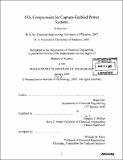CO₂ compression for capture-enabled power systems
Author(s)
Suri, Rajat
DownloadFull printable version (16.91Mb)
Alternative title
Carbon dioxide compression for capture-enabled power systems
Other Contributors
Massachusetts Institute of Technology. Dept. of Chemical Engineering.
Advisor
Gregory J. McRae.
Terms of use
Metadata
Show full item recordAbstract
The objective of this thesis is to evaluate a new carbon dioxide compression technology - shock compression - applied specifically to capture-enabled power plants. Global warming has increased public interest in carbon capture and sequestration technologies (CCS), but these technologies add significant capital and operating cost at present, which creates a significant barrier to adoption. Carbon dioxide compression technology makes up a high proportion of the additional cost required, making it a focal point for engineering efforts to improve the economic feasibility of carbon capture. To this effect, shock compressors have the potential to reduce both operating and capital costs with supporting compression ratios of up to 10:1, requiring less stages and theoretically allowing for the possibility of heat integration with the rest of the plant, allowing waste heat to be recovered from hot interstage compressed carbon dioxide. This thesis first presents a technical context for carbon dioxide compression by providing an overview of capture technologies to build an understanding of the different options being investigated for efficient removal of carbon dioxide from power plant emissions. It then examines conventional compression technologies, and how they have each evolved over time. Sample engineering calculations are performed to model gas streams processed by these conventional compressors. An analysis of shock compression is carried out by first building a background in compressible flow theory, and then using this as a foundation for understanding shock wave theory, especially oblique shocks. The shock compressor design is carefully analyzed using patent information, and a simulation of the physics of the shock compressor is created using equations from the theory section described earlier. (cont.) A heat integration analysis is carried out to compare how conventional compressor technologies compare against the new shock compressor in terms of cooling duty and power recovery when integrated with the carbon dioxide capture unit. Both precombustion IGCC using Selexol and post-combustion MEA configurations are considered and compared. Finally an economic analysis is conducted to determine whether shock compression technology should be attractive to investors and plant managers deciding to support it. Key factors such as market, macroeconomic and technical risk are analyzed for investors, whereas a comparison of capital and operating cost is carried out for plant managers. Relevant risks associated with new compression technologies are also analyzed. It is found that there is no significant operating cost benefit to the shock compressor over the conventional compressor, both costing $3,700/hr for an IGCC plant. Power recovery is simply too low to justify the high power requirements in operating a shock compressor with a 10:1 ratio. The technical claims of the shock compressor (such as projected discharge temperature and pressures) seem reasonable after basic modeling, which shows a higher temperature and pressure than claimed by Ramgen.
Description
Thesis (S.M.)--Massachusetts Institute of Technology, Dept. of Chemical Engineering, 2009. Includes bibliographical references (leaves 182-185).
Date issued
2009Department
Massachusetts Institute of Technology. Department of Chemical EngineeringPublisher
Massachusetts Institute of Technology
Keywords
Chemical Engineering.